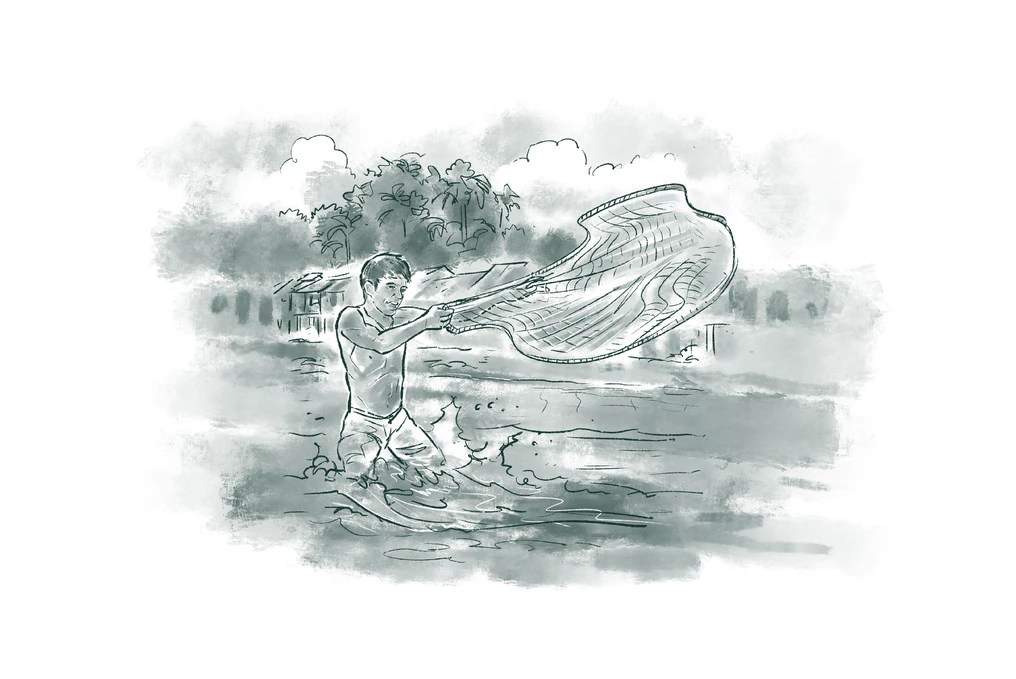All life on Earth began in water. Studies suggest that the first single-celled organisms, the earliest form of life, emerged in the primordial oceans over 3.5 billion years ago1. These tiny organisms evolved into the vast diversity of life we see today.
Dive into the essential role of water in supporting life

Throughout history, societies flourished close to aquatic environments — oceans, seas, rivers, lakes, ponds, groundwater aquifers (reservoirs), etc. — building their cultures, economies, and agriculture on its availability. They regulate our climate, nourish our food systems, and are crucial for nearly every process that sustains life on Earth. Yet, despite their immense value, we continue to destroy these vital resources.
If you take a walk to your nearest waterway, chances are you will find it polluted—whether it’s litter, sewage, or chemicals—slowly choking the life out of it.

The Diverse World Of Aquatic Ecosystems.
Among the various things we can do to preserve the water bodies, the easiest and most basic step is understanding their importance. Let’s dive deep into the diverse world of aquatic ecosystems, explore their significance, understand the various challenges they face, and learn about innovative biosolutions that can help protect them for future generations.

Freshwater environments.
Sweet and Salty Diversity
When it comes to classifying aquatic environments, the simplest way is by their salt content: freshwater and saltwater. Freshwater environments include ponds, rivers, groundwater aquifers, wetlands, and most lakes, while saltwater environments are primarily found in seas, oceans, and some saltwater lakes, bodies of water that are far too salty for us to drink. Despite these broad categories, each ecosystem hosts a variety of specialized life forms that have adapted to their specific conditions, creating a beautiful balance of life in the water.
Freshwater Environments
Less than 1 percent of Earth’s surface is covered by freshwater environments like lakes, rivers, swamps, and wetlands. Despite their small footprint, freshwater environments support around 10 percent of all known species and one-third of all vertebrates (backboned animals including mammals, birds, reptiles, frogs, etc. and fish). These environments are mainly divided into two types of ecosystems: lentic and lotic2.
Saltwater Environments
Saltwater environments cover over 70 percent of our planet, giving rise to the nickname, the “Blue Planet”. But despite this immense stretch of blue, these environments are far from uniform.
Here’s a closer look at a few examples of the different types of saltwater environments:
Coral Reefs
Often referred to as the "rainforests of the sea," coral reefs are vibrant underwater structures made from calcium carbonate secreted by creatures called ‘polyps’. Found in warm, shallow waters, coral reefs are not just beautiful—they are vital for marine biodiversity. Coral reefs support almost 25 percent of all marine life3. They provide food, shelter, and breeding grounds for marine organisms, and are the first line of defense against natural disasters like storms.
Mangroves
Mangrove forests are nature’s tough survivors, thriving where land meets the sea in tropical regions, even in oxygen-poor soils4. Their tangled roots rise above the ground like natural stilts, helping them endure the daily push and pull of the tides. These same roots create a safe haven for young fish, crabs, and shrimp, offering shelter from predators. But mangroves do more than just support marine life—they soften the impact of storms, prevent coastal erosion by stabilizing the coasts, and keep shorelines intact. On top of that, they act as powerful carbon sinks5, locking away large amounts of carbon dioxide that would otherwise heat up our planet.

Seagrass Meadows
Seagrasses are aquatic plants found across six continents, in 159 countries6. Covering over 300,000 square kilometers, they form one of the most widespread coastal habitats on Earth. These plants grow into vast underwater meadows, creating complex, highly productive ecosystems that support a rich diversity of marine life. Despite covering just 0.1 percent of the ocean floor, seagrass meadows provide essential shelter and food for thousands of species, including fish, shellfish, and endangered marine animals like dugongs, seahorses, and sea turtles.

Covering the majority of Earth’s surface, the open ocean might seem like a vast, empty expanse, but it teems with life.
Open Oceans
Covering the majority of Earth’s surface, the open ocean might seem like a vast, empty expanse, but it teems with life. From microscopic plankton to massive whales, the open ocean supports a complex food web. It’s also where major ocean currents help regulate the planet’s climate, distributing heat and nutrients around the globe, which influences weather patterns and supports marine biodiversity.
Each of these ecosystems plays an essential role in maintaining the health of our planet, supporting diverse life forms, and providing benefits to communities. While each freshwater and saltwater ecosystem has its own distinct identity, none exist in isolation. They are connected through various pathways, with the health of one often influencing the well-being of others.
This article is part of The biosolutions bulletin. Want it in your inbox every month?
Interconnectedness of Water Bodies
Aquatic environments are like neighborhoods in a vast, interconnected city. Each has its own unique character—rivers that rush like busy streets, calm lakes that mirror quiet parks, and oceans that stretch like sprawling urban hubs. But just like city districts, these environments don’t exist in isolation. They are linked through a continuous flow of water, nutrients, and life. When one neighborhood thrives, it supports the others. When one struggles, the effects ripple out. Understanding these connections is key to protecting the health and balance of our planet’s aquatic systems.
Let’s look at an example to better understand.
But this is only part of the story. Beneath our feet, groundwater—the water stored deep underground in aquifers—also plays a key role in this interconnected system. Rivers, lakes, and wetlands don’t just release water into the atmosphere and ocean; they also recharge groundwater. Water from these surface bodies seeps into the ground, replenishing the aquifers below. In return, groundwater can slowly filter up into rivers or lakes, maintaining their water levels, especially during dry periods.
This interconnectedness between different aquatic environments keeps the entire system in balance, supporting diverse lifeforms and activities across the planet. However, when chemicals, plastics, or other contaminants enter the picture, this interconnectedness becomes a vulnerability.
The contaminants don’t remain contained in the aquatic environment they enter. The contamination that starts in one small part of an aquatic environment can eventually spread, harming ecosystems along the way—lakes, rivers, estuaries, wetlands, and even the vast oceans. Groundwater contamination can also have long-term effects, potentially tainting drinking water and agricultural systems that millions of people rely on.
By understanding these connections, we can begin to comprehend how vital it is to protect every aquatic environment. Protecting our water is not just about preserving isolated aquatic environments. It’s about ensuring the health of the entire planet.
The Challenges
For millions of years, aquatic environments have sustained life, shaping ecosystems and supporting countless species. But today, human activities are pushing these delicate systems to the brink. If these pressures continue unchecked, they could destabilize entire ecosystems, with consequences that ripple far beyond the water. Let’s take a closer look at some of the most pressing threats.

Overfishing and Habitat Destruction
Overfishing is depleting fish populations at an alarming rate, threatening biodiversity and destroying marine habitats. More than 3 billion people depend on seafood for nutrition, yet over half of the fish consumed comes from wild-caught sources rather than fish farming7. This intense demand is pushing fish populations toward collapse.
According to the United Nations (FAO), the number of overfished stocks has tripled in the past 50 years8. Freshwater fish are also in danger—nearly one-third of species face extinction, and migratory freshwater fish populations have dropped by a staggering 76% since 1970.
But the damage goes beyond just species loss. Healthy oceans absorb over 25% of global CO2 emissions, and fish play a crucial role in this process. If overfishing continues, it won’t just threaten food security—it will also weaken the ocean’s ability to store carbon, accelerating climate change.
Climate Change
Climate change is fundamentally reshaping aquatic environments, disrupting both freshwater and marine ecosystems. Rising water temperatures have already reduced the growth rates of some aquatic species by as much as 30%9. These changes affect everything from fish populations to entire food webs, putting both nature and human livelihoods at risk.
Chemical Contamination
Chemicals are a part of modern life, used in everything from household products to industrial manufacturing and agriculture. But once released into the environment—through wastewater from homes, farms, and factories—they contaminate water sources, spreading across rivers, lakes, and oceans.
While not all chemicals are harmful, several pose serious risks. Toxic substances such as pesticides, heavy metals, bleach, dyes, and "forever chemicals"—which do not break down and persist in the environment indefinitely—can have devastating effects on aquatic life and human health.

Plastic, Waste, and Other Pollutants
Chemical pollution is just one piece of the puzzle. Aquatic environments are also under siege from plastic waste, oil spills, discarded textiles, and mountains of garbage. These pollutants don’t just make water bodies look unsightly—they destroy ecosystems.
The scale of these challenges may seem overwhelming, but nature itself offers powerful solutions. Across the world, innovative biosolutions—harnessing the power of enzymes, microbes, and other biological processes—are helping to restore balance in aquatic environments. While they clearly won’t solve every problem, they represent an important opportunity crucial step toward more sustainable and resilient water ecosystems:

How biosolutions are helping
Making detergent more waterway friendly
Sewage pollution is a major threat to freshwater ecosystems, carrying chemicals from household products like detergents. Detergents contain surfactants—chemical compounds derived from fossil fuels that help break down stains. Each year, an estimated 15 million tonnes of surfactants are produced globally, with about 60 percent ultimately entering aquatic environments.
Biosolutions offer a more sustainable alternative by reducing the reliance on fossil-fuel-based surfactants without compromising cleaning performance. Certain microorganisms, such as bacteria and yeast, can produce biosurfactants that are biodegradable, less toxic, and effective even at high temperatures10.
Making wastewater treatment more efficient
Beyond detergents, biosolutions also improve wastewater treatment. Around 113 billion liters11 of household sewage are discharged into aquatic environments annually without proper treatment, making water unsafe for both wildlife and humans.
By harnessing nature’s own processes, biosolutions make wastewater treatment more effective and environmentally friendly.
Reducing the Impact of Aquaculture
As overfishing depletes wild fish stocks, aquaculture is emerging as an alternative. However, fish farming can bring environmental challenges, such as disease outbreaks, antibiotic overuse, and pollution from feed waste. Biosolutions are helping make aquaculture more sustainable through:
- Bacteria that keep the aquaculture pond clean, reducing fish and shrimp mortality and improving the yields.
- Fermentation-based fish feed made from algae provides a sustainable alternative to traditional fishmeal.
- Probiotics support fish gut health, reducing the need for antibiotics and lowering the risk of harmful substances entering aquatic ecosystems.
By integrating biosolutions, aquaculture can meet growing global seafood demand while reducing its ecological footprint.
Preventing Agricultural Runoff
Agriculture is essential for food production but significantly affects water quality. Chemical pesticides and fertilizers often wash into rivers, lakes, and oceans, harming aquatic life. Biosolutions like biopesticides and biostimulants help reduce this impact while maintaining crop productivity.
Biopesticides, derived from natural sources such as bacteria, fungi, or plant extracts, target specific pests without leaving harmful residues. Unlike chemical pesticides, which can persist in the environment and contaminate water, biopesticides break down quickly, reducing risks to aquatic ecosystems.
Biostimulants, made from seaweed extracts, beneficial microbes, and organic acids, enhance plant nutrient absorption and root strength. By improving soil health and reducing reliance on synthetic fertilizers, they help prevent nutrient runoff, a major cause of algal blooms and oxygen depletion in water bodies.
By adopting biopesticides and biostimulants, farmers can protect water quality while ensuring sustainable food production, reducing pollution, and minimizing harm to aquatic environments.
Reducing reliance on chemicals with biosolutions
Many industries depend on harsh chemicals that pollute water, but biosolutions are offering safer alternatives. The textile and leather industries, for example, release large amounts of toxic dyes, tanning agents, and finishing chemicals into rivers and lakes. Biosolutions are helping to change this by replacing these harmful substances with natural, enzyme-based alternatives.
By adopting these biosolutions, these industries can significantly cut pollution, preserve water quality, and move toward more sustainable production methods.
The way forward
Aquatic environments face immense challenges—from pollution and habitat destruction to climate change and overfishing. While no single measure can address all these threats, biosolutions offer a powerful, biology-based approach to reducing harm and restoring balance for future generations. By harnessing the potential of microbes, enzymes, and other biological innovations, we can reduce water pollution, improve water quality, and create healthier aquatic ecosystems, when combined with better policies, responsible industry practices, and global cooperation.

Biosolutions enhance aquaculture productivity
Aquaculture is feeding billions, but challenges like water contamination and disease outbreaks threaten its sustainability. This article explore how biosolutions—powered by beneficial microbes—are tackling these issues.
Read the article and learn how biosolutions improve water quality, reduce reliance on antibiotics, and increase productivity in fish farming.
What is a biosolution?
Microbes and enzymes are tiny but mighty agents of change. For billions of years, they’ve enabled transformation in all living things through microbiology.

All you need to know about biosolutions, delivered monthly
Biosolutions are fascinating but can be difficult to grasp. That's why we created the monthly Biosolutions Bulletin — to break down the science into easy-to-understand, engaging stories with beautiful hand-drawn illustrations.
Each issue dives deep into the science behind biosolutions and their roles in transforming everything from agriculture to industries and the products we use every day.
Sign up today to stay updated!
One more step…
To complete the get in touch form or sign up, please click on the button below to enable cookies.
1. Timeline of the evolution of life on Earth
2. Aquatic Ecosystem - Introduction
3. Coral Reefs
4. What is a mangrove forest? NOAA
5. Mangroves. National Park Service
7. The state of world fisheries and aquaculture 2024
9. Implications of climate change on freshwater ecosystems and their biodiversity
10. The Call for Green Cleaners: Impact of Microbial Biosurfactants on the Detergents Industry
11. United Nations